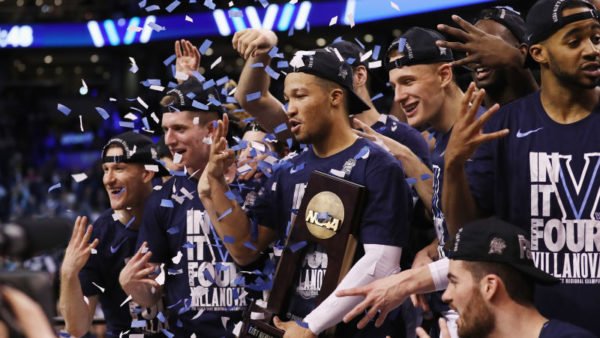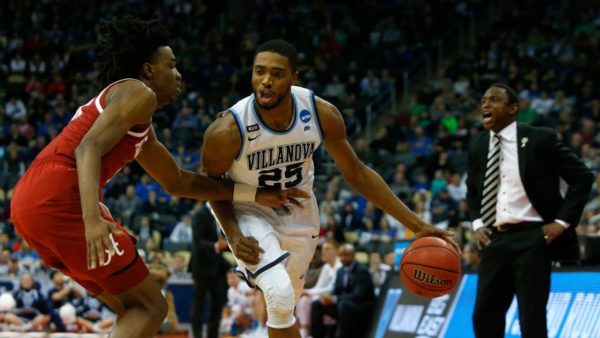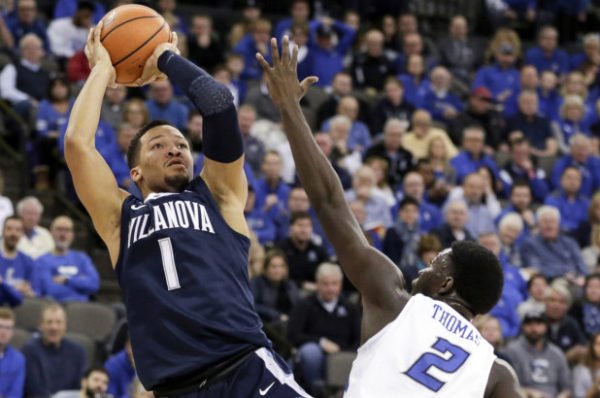Final Four Fact Sheet: Villanova Wildcats
Posted by Tommy Lemoine on March 27th, 2018Now that the Final Four is set, our writers have put together a fact sheet on each of the four teams still remaining. Next up is #1 Villanova from the East Region.
How Villanova Got Here

Villanova is headed back in the Final Four. (Maddie Meyer/Getty Images)
East Region Champions. In a March defined by massive upsets, close games, and wild finishes, Villanova cruised to San Antonio without too much trouble. On opening weekend, the Wildcats beat #16 Radford by 27 points before hammering #9 Alabama, 81-58, two days later. In its Sweet Sixteen tilt with West Virginia, Jay Wright’s group used a 22-6 second half run to overcome a two-possession deficit and beat the Mountaineers by 12 points. On Sunday, Villanova put forth one of its best defensive efforts of the season, limiting Texas Tech to 0.89 points per possession in another 12-point win. The Wildcats now head to their second Final Four in three seasons, this time as the odds-on favorites to win it all.
The Coach
Jay Wright. The sharply dressed 56-year-old is working his way on to the Mount Rushmore of active head basketball coaches, and its hard to argue otherwise. Wright became the winningest coach in school history earlier this month and is currently in the midst of his fourth-straight 30-win season, which gives him as many such campaigns (five) as Syracuse’s Jim Boehiem and one more than Michigan State’s Tom Izzo (four). In fact, he has gone a remarkable 163-21 over the past five seasons, never once losing more than five games during that span. Now with three Final Four appearances under his belt, Wright is tied with Kansas’ Bill Self and Mississippi State’s Ben Howland for sixth-most among active coaches, and has a chance to join Duke’s Mike Krzyzewski and North Carolina’s Roy Williams as the only active head coaches with multiple National Championships.
Style
Villanova runs a four-out, one-in motion offense that relies on floor spacing, crisp ball movement, dribble-penetration and great perimeter shooting. The Wildcats, in fact, take 47.1 percent of their shots from behind the arc, which is substantially more than even the three-point reliant Jayhawks (41.4%) or Wolverines (43.1%). And there’s nothing excessive about it. Since every player on the floor is capable of penetrating, all it takes is one help defender to free up an open man somewhere on the court. And considering how well Villanova moves the ball — perhaps no team makes the “extra pass” as often as the Wildcats — that open man often finds the ball in his hands. The result is college basketball’s most efficient offense since 2015. Defensively, Villanova mixes defenses, sometimes running a zone press that’s proved effective throughout Wright’s career. The Wildcats also guard the perimeter aggressively, one reason they rank 29th nationally in three-point defense (32.2% 3FG).
Strengths

Mikal Bridges (17.8 PPG) is just one reason the Wildcats are so explosive. (Getty Images)
- Three-point shooting. This may seem obvious, but it cannot be overstated. Villanova is the only team in America that takes over 45 percent of its shots from behind the arc and shoots over 40 percent from that distance. Five different Wildcats are shooting 39 percent or better from long range on more than 130 attempts, which means virtually everyone on the floor can make you pay. Problem is, with elite dribble penetrators like Jalen Brunson and Mikal Bridges, there’s virtually no way to consistently deny the paint and take away Villanova’s open three-point looks. They always find a way to make opponents pay.
- Ball security. There was a stretch versus West Virginia’s relentless pressure last weekend where the Wildcats looked flustered, turning the ball over in spurts and surrendering several easy baskets. But then they figured it out, which is no surprise considering their personnel. In point guard Brunson, Villanova has a true floor general whose offensive prowess is matched only by his ball skills. Despite playing big minutes (31.8 MPG) and using a lot of possessions (26.1% possession rate), the junior boasts one of the lowest turnover rates in the country among heavily-used players, and by far the lowest among starting point guards in the Final Four. Brunson only coughed it up three times against the Mountaineers. In fact, Villanova as a team ranks 14th nationally in offensive turnover rate. The fewer the turnovers, the more possessions for its explosive offense to operate.
- Defensive intensity. Believe it or not, Villanova’s defense has been nearly as dominant as its offense this March, which is certainly saying something. On Sunday — despite one of its worst shooting performances of the season (4-of-24 3FG) — the Wildcats held Texas Tech to an NCAA Tournament-low 0.89 points per possession, hammering the Red Raiders on the glass and limiting their opponents to under 37 percent shooting for the fifth straight game. With long, athletic forwards like Omari Spellman, Eric Paschall and Mikal Bridges, Villanova often makes opponents think they have an open shot or lane to the basket, only to close out aggressively. Throughout the NCAA Tournament, consecutive defensive stops has often fueled big scoring runs on the other end. Texas Tech coach Chris Beard said it best on Sunday: “You think it’s their three-point shooting, their small ball, their athleticism, but by far, their identity is their toughness.”
Weaknesses
- Depth. Villanova doesn’t foul at a high rate, so this is not often an issue. Still, in their Valentine’s Day loss to Providence, the Wildcats sent the Friars to the free throw line 30 times and both Brunson and Bridges fouled out. Without Phil Booth in the lineup, their general lack of depth was exposed. Considering how important players like Brunson and Bridges are to Villanova’s success — not to mention the fact that it ranks 301st in bench minutes — Wright’s best players simply can’t afford to pick up early fouls. The good news? Kansas ranks 330th nationally in free throw rate.
- Rim protection. We’re nitpicking here, sure (newsflash: This team is really good), but it’s worth noting that the only player in Villanova’s lineup stands taller than 6’8″. And considering that it surrenders the majority of its points in the paint, that could be a problem against a Kansas center Udoka Azubuike, who — at 7’0″ — leads the country in two-point percentage (77% 2FG). When the Wildcats won the National Championship in 2016, they had 6’11” center Daniel Ochefu available to defend against North Carolina’s bigs. This season, neither Ochefu nor anyone like him is manning the paint.
- Offensive rebounding. Wait a minute, didn’t the Wildcats just crush Texas Tech on the offensive glass? They sure did, and it was impressive (20 offensive rebounds). Still, Villanova ranked just eighth in the Big East in offensive rebounding rate this season, a product of their spread-out system and lack of great individual rebounders beyond Spellman (7.8 RPG). Against the Red Raiders, the Wildcats’ effort on the offensive glass helped them overcome a rare poor shooting night; in losses to Providence and St. John’s earlier this season, that was not the case.
Go-To Scorer

Jalen Brunson is not afraid to do work in the post. (Associated Press)
Jalen Brunson (19.2 PPG). The Big East Player of the Year shoots 41 percent from behind the arc and can gash opponents with his mid-range pull-ups, floaters and free throws. And yet, Brunson arguably does his best work in the post. That’s right: despite standing just 6’2″, the junior point guard regularly backs down larger defenders near the basket, using his patience and craft post moves — including his signature back pivot — to do damage. Texas Tech’s Beard again said it best: “It was like watching Magic Johnson back down.”
X-Factor
Omari Spellman (10.8 PPG, 7.8 RPG). Spellman was outstanding in Boston last weekend, scoring 18 points against West Virginia and 11 points against Texas Tech. At 6’9″, the freshman’s ability to knock down threes (44.6% 3FG) helps further stretch defenses already stressed by Villanova’s spread attack. Spellman is also the team’s best rebounder and interior defender, at times generating momentum with big blocks like this one against West Virginia in the Sweet Sixteen. Spellman will necessarily play a big role against Kansas.
Outlook
Based on KenPom’s adjusted efficiency margin, Villanova is college basketball’s best team over the last three seasons. The Wildcats boast the second-most efficient offense since at least 2002 — topped only by 2015 Wisconsin — and both Brunson and Bridges rank among the country’s 15 most efficient offensive players (minimum 20 percent of possessions used). On top of that, the East Region champions have lost just twice this season when playing at full strength, looking more dominant than ever during the month of March. Despite both being #1 seeds, Villanova opened as a 5.5-point favorite against Kansas, which should tell you something about just how good this team is. The Wildcats are poised for a second National Championship in three seasons.









































